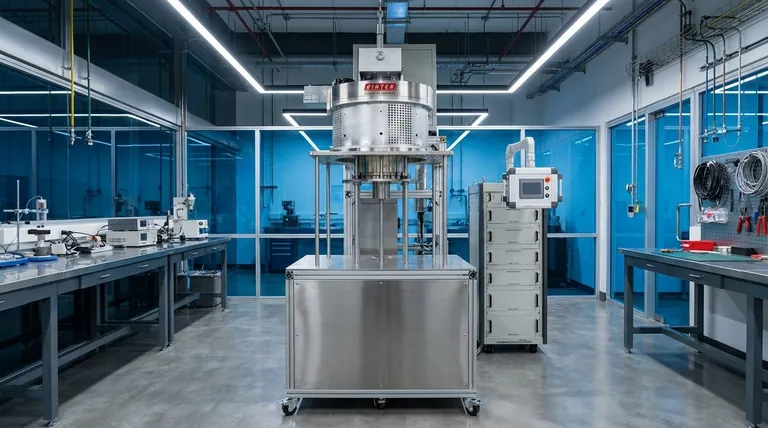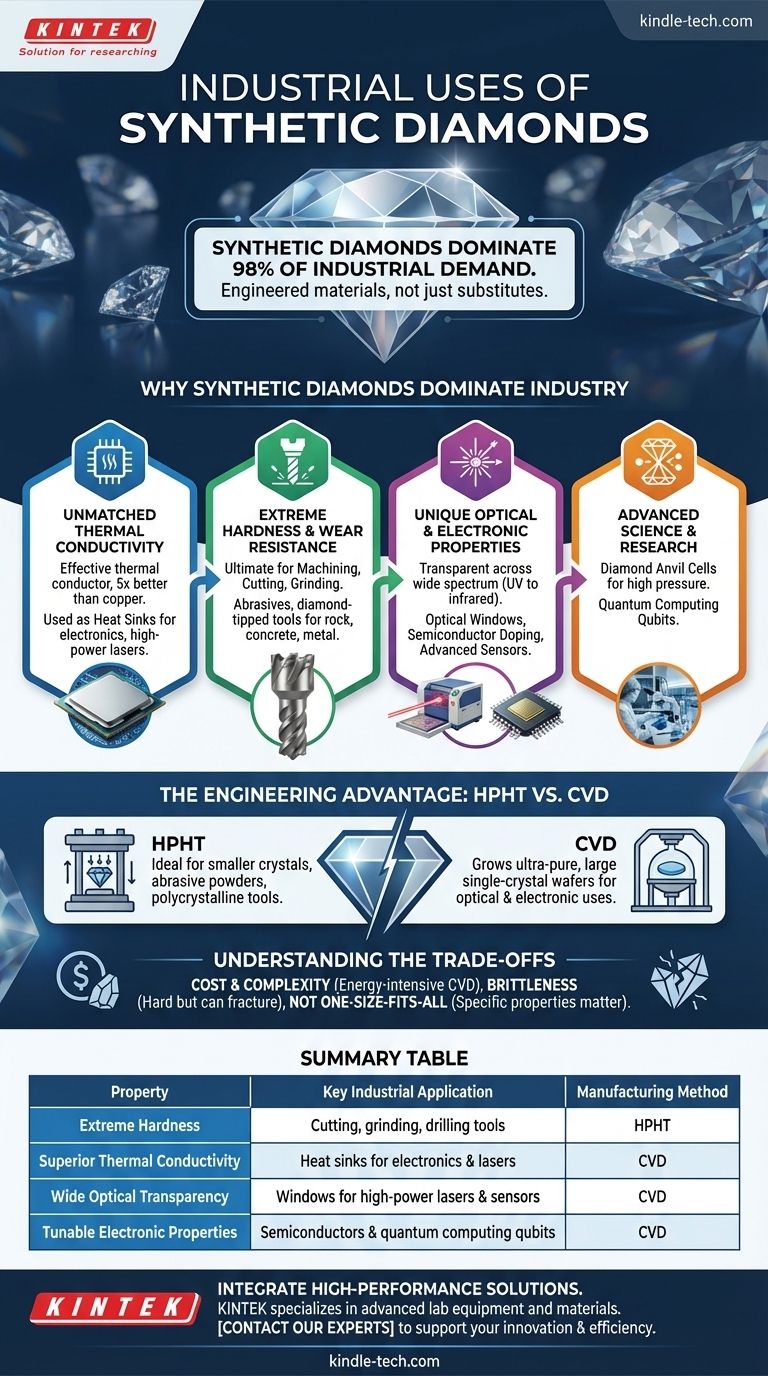In industry, synthetic diamonds are not just substitutes for natural stones; they are highly engineered materials used for everything from cutting and grinding the hardest materials to managing heat in advanced electronics and serving as transparent windows for high-power lasers. Their applications also extend to pioneering fields like quantum computing and high-pressure scientific research, where their unique combination of properties is indispensable.
The core takeaway is that synthetic diamonds now dominate industrial applications, accounting for an estimated 98% of demand. This is because manufacturing methods like HPHT and CVD allow for the creation of diamonds with specific, often superior, properties tailored for tasks far beyond simple abrasion.

Why Synthetic Diamonds Dominate Industry
The value of synthetic diamond extends far beyond its famous hardness. It is a material of extremes, offering a combination of properties unmatched by any other substance, which can be precisely tuned during manufacturing.
The Engineering Advantage: HPHT vs. CVD
The two primary manufacturing methods, High Pressure/High Temperature (HPHT) and Chemical Vapor Deposition (CVD), are not interchangeable. Each process yields diamonds with distinct characteristics.
HPHT typically produces batches of smaller crystals, ideal for creating abrasive powders and durable polycrystalline cutting tools.
CVD, on the other hand, "grows" diamond as a film on a substrate, allowing for the creation of large, ultra-pure, single-crystal wafers perfect for optical and electronic applications.
Unmatched Thermal Conductivity
Diamond is the most effective thermal conductor known at room temperature, surpassing copper by a factor of five.
This makes it an ideal heat sink or "heat spreader," rapidly drawing damaging heat away from sensitive components like high-power laser diodes, transistors, and microprocessors.
Extreme Hardness and Wear Resistance
This is the most traditional and largest application by volume. The extreme hardness of diamond makes it the ultimate material for machining, cutting, and grinding.
Synthetic diamond powders are used as abrasives for polishing superhard materials. Diamond-tipped drill bits and saws cut through rock, concrete, and metal with unparalleled efficiency.
Unique Optical and Electronic Properties
High-purity synthetic diamond is transparent across an exceptionally wide spectrum of light, from ultraviolet to far-infrared and even microwaves.
This makes it the perfect material for durable optical windows in high-power CO2 lasers or protective domes for sensors in harsh environments. Its specific electronic structure also allows it to be "doped" to function as a high-performance semiconductor.
Key Industrial Applications in Practice
The theoretical properties of synthetic diamond translate into critical, real-world applications across numerous high-tech sectors.
In Machining and Manufacturing
This is the workhorse application. Nearly all industrial-grade diamond for cutting tools, drill bits, saw blades, and grinding wheels is synthetic. Its consistency and tailored properties deliver predictable performance that natural diamond cannot match.
In Electronics and Thermal Management
In advanced electronics, synthetic diamond substrates act as heat spreaders, preventing overheating in high-frequency transistors and powerful computer chips. This allows for smaller, more powerful electronic devices.
In Optics and Advanced Sensors
CVD diamond is used to create robust windows for industrial lasers and scientific equipment. Its ability to withstand extreme heat and chemical corrosion makes it ideal for protecting sensitive optical components. It is also used to create highly sensitive detectors for UV rays, X-rays, and other high-energy particles.
In Advanced Science and Research
Two single-crystal diamonds can be pressed together to form a diamond anvil cell, creating immense pressures to study how materials behave under conditions like those at the Earth's core. Furthermore, defects engineered into the diamond lattice can act as qubits, the fundamental building blocks of quantum computers.
Understanding the Trade-offs
While incredibly capable, synthetic diamond is not a universally perfect solution. Understanding its limitations is key to using it effectively.
Cost and Complexity of Manufacturing
Producing large, high-purity, single-crystal diamonds via CVD is an energy-intensive and technically complex process. The cost can be a significant barrier for applications that do not absolutely require its extreme performance.
Not a "One-Size-Fits-All" Material
The properties of a diamond designed for a drill bit are vastly different from one made for a semiconductor wafer. The choice between HPHT and CVD, and the specific "recipe" used, is critical. Using the wrong type of synthetic diamond can lead to poor performance or failure.
Brittleness Despite Hardness
Like most ceramic materials, diamond is incredibly hard but also brittle. While it resists scratching and wear, a sharp impact at the wrong angle can cause it to fracture. This must be considered in the design of tools and components.
Making the Right Choice for Your Application
The right type of diamond is dictated entirely by your primary goal.
- If your primary focus is mechanical performance (cutting, grinding): You need polycrystalline diamond, often from HPHT, for its superior toughness and wear resistance in abrasive applications.
- If your primary focus is thermal management (heat sinks): You need high-purity diamond, often from CVD, to achieve the highest possible thermal conductivity for dissipating heat.
- If your primary focus is optical or electronic performance: You need flawless, single-crystal, ultra-pure CVD diamond tailored for specific transparency or semiconductor properties.
Ultimately, synthetic diamond has evolved from a simple industrial abrasive into a foundational material for the next generation of technology.
Summary Table:
| Property | Key Industrial Application | Manufacturing Method |
|---|---|---|
| Extreme Hardness | Cutting, grinding, drilling tools | HPHT |
| Superior Thermal Conductivity | Heat sinks for electronics & lasers | CVD |
| Wide Optical Transparency | Windows for high-power lasers & sensors | CVD |
| Tunable Electronic Properties | Semiconductors & quantum computing qubits | CVD |
Ready to integrate high-performance synthetic diamond solutions into your lab or manufacturing process? KINTEK specializes in providing advanced lab equipment and consumables, including materials tailored for cutting-edge applications. Our expertise ensures you get the right synthetic diamond product for your specific needs in thermal management, precision machining, or advanced research. Contact our experts today to discuss how we can support your laboratory's innovation and efficiency.
Visual Guide

Related Products
- 915MHz MPCVD Diamond Machine Microwave Plasma Chemical Vapor Deposition System Reactor
- Cylindrical Resonator MPCVD Machine System Reactor for Microwave Plasma Chemical Vapor Deposition and Lab Diamond Growth
- Customer Made Versatile CVD Tube Furnace Chemical Vapor Deposition Chamber System Equipment
- HFCVD Machine System Equipment for Drawing Die Nano-Diamond Coating
- CVD Diamond Domes for Industrial and Scientific Applications
People Also Ask
- What is MPCVD? Unlock Atom-by-Atom Precision for High-Purity Materials
- What is MPCVD method? A Guide to High-Purity Diamond Synthesis
- What is microwave plasma CVD? A Guide to High-Purity Diamond and Material Synthesis
- What are the advantages of microwave plasma? Faster, Purer Processing for Demanding Applications
- What is the microwave plasma method? A Guide to High-Purity Material Synthesis



















